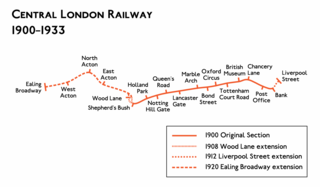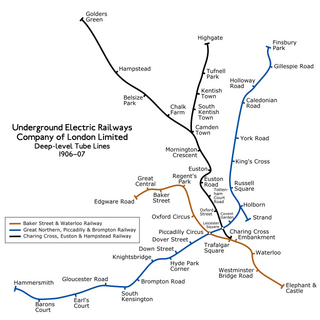
The Central line is a London Underground line that runs through central London, from Epping, Essex, in the north-east to Ealing Broadway and West Ruislip in west London. Printed in red on the Tube map, the line serves 49 stations over 46 miles (74 km). It is one of only two lines on the Underground network to cross the Greater London boundary, the other being the Metropolitan line. One of London's deep-level railways, Central line trains are smaller than those on British main lines.

Charing Cross is a London Underground station at Charing Cross in the City of Westminster. The station is served by the Bakerloo and Northern lines and provides an interchange with Charing Cross mainline station. On the Bakerloo line it is between Embankment and Piccadilly Circus stations and on the Northern line it is between Embankment and Leicester Square stations. The station is in fare zone 1.

The City and South London Railway (C&SLR) was the first successful deep-level underground "tube" railway in the world, and the first major railway to use electric traction. The railway was originally intended for cable-hauled trains, but owing to the bankruptcy of the cable contractor during construction, a system of electric traction using electric locomotives—an experimental technology at the time—was chosen instead.

Turnham Green is a London Underground station in Chiswick of the London Borough of Hounslow, west London. The station is served by the District and Piccadilly lines although currently Piccadilly line trains normally stop at the station only at the beginning and end of the day, running through non-stop at other times. To the east, District line trains stop at Stamford Brook and Piccadilly line trains stop at Hammersmith. To the west, District line trains run to either Chiswick Park or Gunnersbury and Piccadilly line trains stop at Acton Town. The station is in both Travelcard Zone 2 and Zone 3.

The Metropolitan District Railway, also known as the District Railway, was a passenger railway that served London from 1868 to 1933. Established in 1864 to complete an "inner circle" of lines connecting railway termini in London, the first part of the line opened using gas-lit wooden carriages hauled by steam locomotives. The Metropolitan Railway operated all services until the District Railway introduced its own trains in 1871. The railway was soon extended westwards through Earl's Court to Fulham, Richmond, Ealing and Hounslow. After completing the inner circle and reaching Whitechapel in 1884, it was extended to Upminster in Essex in 1902.

The Central London Railway (CLR), also known as the Twopenny Tube, was a deep-level, underground "tube" railway that opened in London in 1900. The CLR's tunnels and stations form the central section of the London Underground's Central line.

Gunnersbury is a London Overground and London Underground station in Gunnersbury in London, England on the North London line. The station opened on 1 January 1869 and is served by District line trains to and from Richmond, and by Arriva Rail London on the London Overground network. On the District line the station is between Turnham Green and Kew Gardens, and on the North London line it is between South Acton and Kew Gardens.

Ravenscourt Park is a London Underground station located in west Hammersmith, west London. The station is served by the District line and is between Hammersmith and Stamford Brook stations.

The Charing Cross, Euston and Hampstead Railway (CCE&HR), also known as the Hampstead Tube, was a railway company established in 1891 that constructed a deep-level underground "tube" railway in London. Construction of the CCE&HR was delayed for more than a decade while funding was sought. In 1900 it became a subsidiary of the Underground Electric Railways Company of London (UERL), controlled by American financier Charles Yerkes. The UERL quickly raised the funds, mainly from foreign investors. Various routes were planned, but a number of these were rejected by Parliament. Plans for tunnels under Hampstead Heath were authorised, despite opposition by many local residents who believed they would damage the ecology of the Heath.

Hammersmith was a railway station on the London and South Western Railway (LSWR), located on Grove Road in Hammersmith, west London. It was opened in 1869 and closed in 1916.

Shepherd's Bush is a closed London and South Western Railway (L&SWR) station in Shepherd's Bush, west London. The station was situated on the L&SWR's line between Richmond and the West London Joint Railway (WLJR). It was between Hammersmith station and Addison Road station.
The Wimbledon and Sutton Railway (W&SR) was a railway company established by an Act of Parliament in 1910 to build a railway line in Surrey from Wimbledon to Sutton via Merton and Morden in the United Kingdom. The railway was promoted by local landowners hoping to increase the value of their land through its development for housing. It was initially planned that services on the railway would be operated by the London Underground's District Railway (DR) by an extension of its existing service from Wimbledon.

The Great Northern, Piccadilly and Brompton Railway (GNP&BR), also known as the Piccadilly tube, was a railway company established in 1902 that constructed a deep-level underground "tube" railway in London. The GNP&BR was formed through a merger of two older companies, the Brompton and Piccadilly Circus Railway (B&PCR) and the Great Northern and Strand Railway (GN&SR). It also incorporated part of a tube route planned by a third company, the District Railway (DR). The combined company was a subsidiary of the Underground Electric Railways Company of London (UERL).

The Baker Street and Waterloo Railway (BS&WR), also known as the Bakerloo tube, was a railway company established in 1893 that built a deep-level underground "tube" railway in London. The company struggled to fund the work, and construction did not begin until 1898. In 1900, work was hit by the financial collapse of its parent company, the London & Globe Finance Corporation, through the fraud of Whitaker Wright, its main shareholder. In 1902, the BS&WR became a subsidiary of the Underground Electric Railways Company of London (UERL) controlled by American financier Charles Yerkes. The UERL quickly raised the funds, mainly from foreign investors.
The transport system now known as the London Underground began in 1863 with the Metropolitan Railway, the world's first underground railway. Over the next forty years, the early sub-surface lines reached out from the urban centre of the capital into the surrounding rural margins, leading to the development of new commuter suburbs. At the turn of the nineteenth century, new technology—including electric locomotives and improvements to the tunnelling shield—enabled new companies to construct a series of "tube" lines deeper underground. Initially rivals, the tube railway companies began to co-operate in advertising and through shared branding, eventually consolidating under the single ownership of the Underground Electric Railways Company of London (UERL), with lines stretching across London.
Emlyn Road or Stamford Gardens was an authorised underground railway station planned by the Central London Railway (CLR) but never built. It was to be located near Stamford Brook Common at the junction of Emlyn Road, Stamford Brook Road, Bath Road and Prebend Gardens in Chiswick, in west London.
Heathfield Terrace was an authorised underground railway station planned by the Central London Railway (CLR) but never built. It was to be located at the north-east corner of Turnham Green at the junction of Heathfield Terrace and Chiswick High Road, in Chiswick, in west London.
Rylett Road was an authorised underground railway station planned by the Central London Railway (CLR) but never built. It was to be located at the junction of Rylett Road and Goldhawk Road in Hammersmith, in west London.
Paddenswick Road was an authorised underground railway station planned by the Central London Railway (CLR) but never built. It was to be located at the junction of Paddenswick Road and Goldhawk Road in Hammersmith, in west London.

The Underground Electric Railways Company of London Limited (UERL), known operationally as the Underground for much of its existence, was established in 1902. It was the holding company for the three deep-level "tube" underground railway lines opened in London during 1906 and 1907: the Baker Street and Waterloo Railway, the Charing Cross, Euston and Hampstead Railway and the Great Northern, Piccadilly and Brompton Railway. It was also the parent company from 1902 of the District Railway, which it electrified between 1903 and 1905. The UERL is a precursor of today's London Underground; its three tube lines form the central sections of today's Bakerloo, Northern and Piccadilly lines.
















